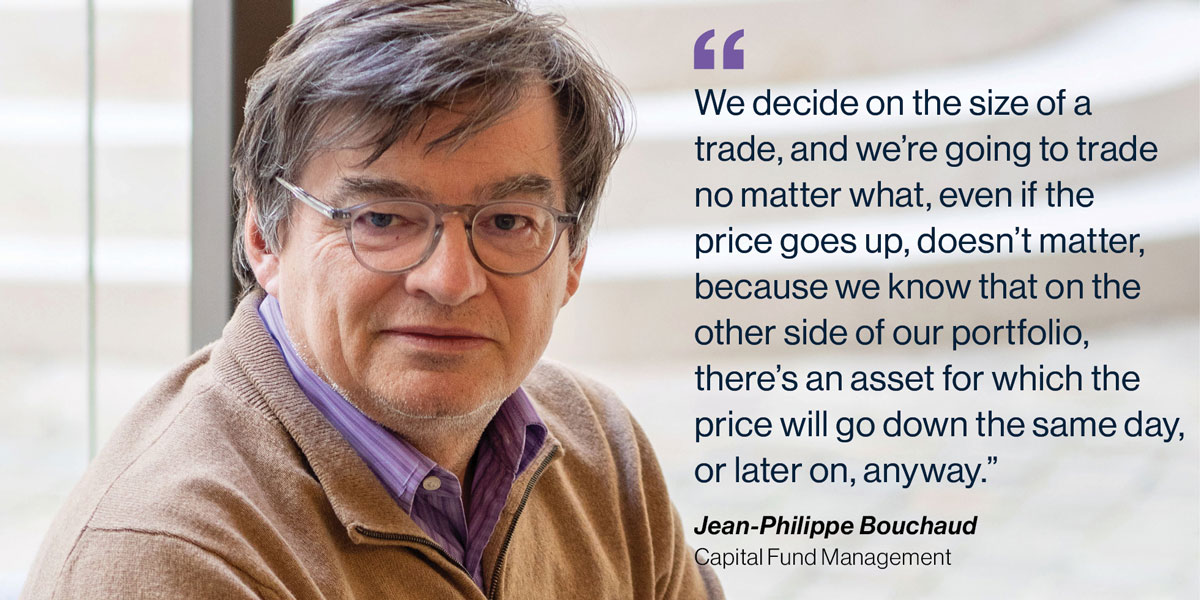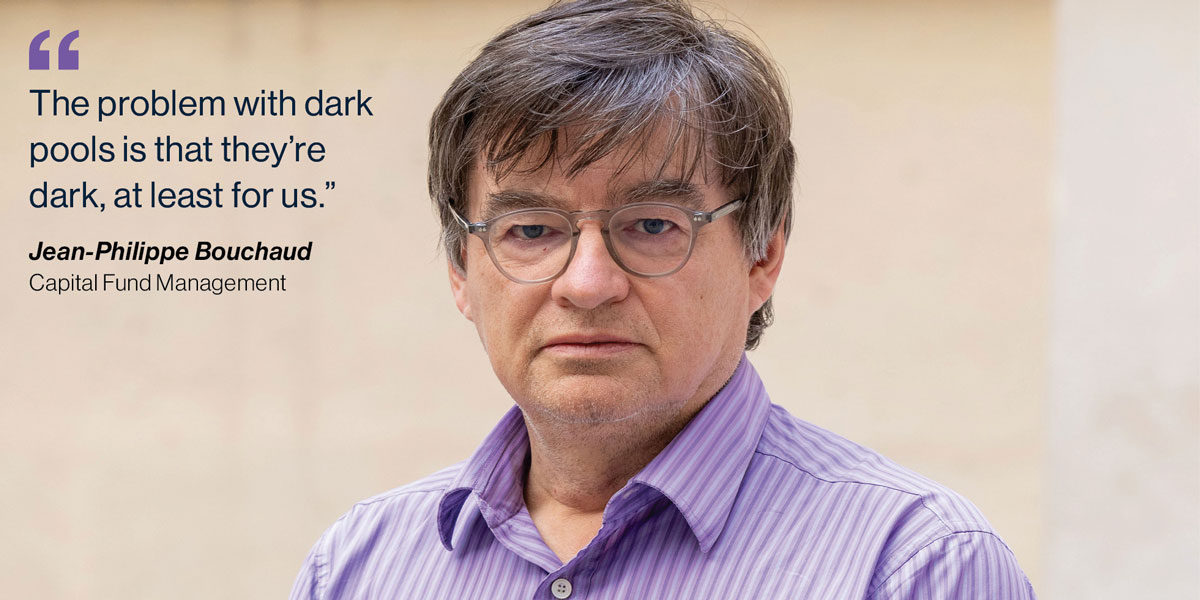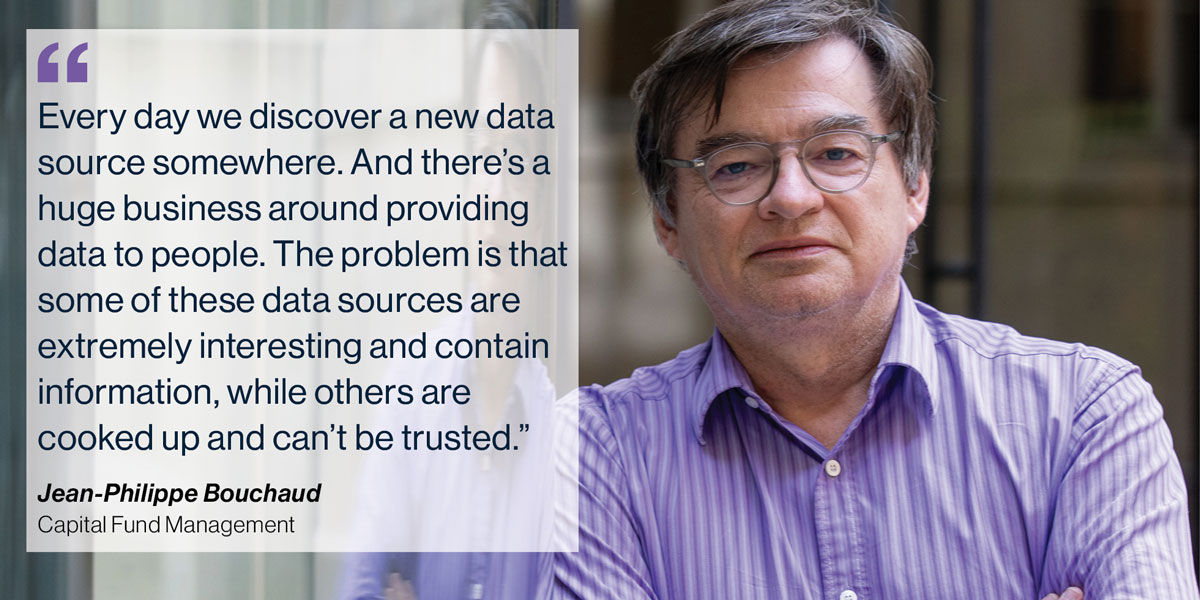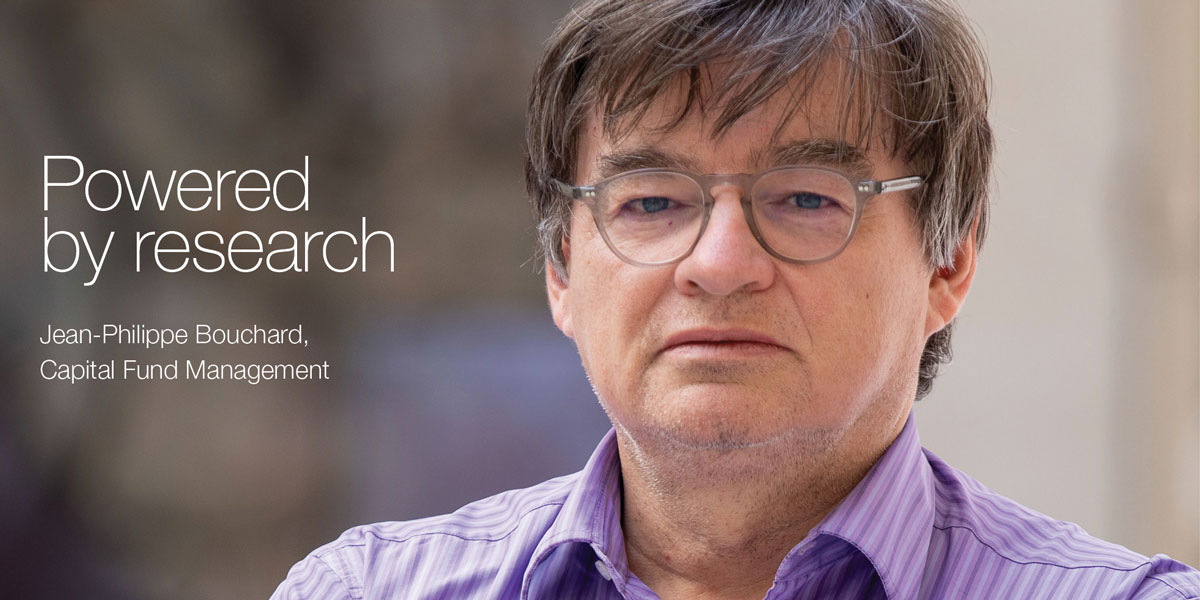The world’s foremost experts in trading and market microstructure and their youthful research team have turned Capital Fund Management (CFM) into a hedge fund giant whilst employing almost no traders. Nick Dunbar spoke with CFM’s co-founder Jean-Philippe Bouchaud.
Walking through Paris’s Left Bank to the offices of Capital Fund Management, it is easy to forget one is visiting a financial institution. Students from nearby Sciences-Po throng the streets, not investment bankers, and a similar relaxed, youthful vibe pervades CFM’s offices. That is exactly how CFM co-founder and chairman Jean-Philippe Bouchaud likes it.
“Junior people have direct access to the founders of the firm,” he says. “The hierarchy is very flat, I don’t know how many firms work like this. But I think it’s very common in universities that you go and see a Nobel Prize winner that’s working in your department. He sits in his office, opens his door and discusses with you.”
The difference is that this ‘university department’ is a US$17 billion hedge fund running a portfolio of diverse, systematic strategies. With eight times leverage, holding thousands of different stocks, futures and options, with a 20-40 day median lifetime, CFM trades hundreds of billions in volume per year.
But the real surprise is that the firm employs almost no traders, relying for the most part on algos designed by its 100-strong team of researchers and 200 developers. Other than financing, CFM uses no broker algos for trade execution. It is just as well that Bouchaud, and co-founder Marc Potters, are considered to be the world’s leading experts in the theory of trading and market microstructure.
“For us, market structure is really important, because unlike other firms who go through brokers who execute their trades, all the execution is done in-house” Bouchaud says. “So we’re extremely interested in market microstructure.”
Before speaking to Bouchaud, it helps to have read his 2017 monograph ‘Trades, Quotes & Prices’ (co-authored with Julius Bonart, Jonathan Donier and Martin Gould). Packed with equations, the book embodies CFM’s guiding philosophy, which opposes the ‘efficient market’ economics dogma, according to which prices reflect new information.
“We believe that most market moves are really due to impact of others,” counters Bouchaud. Years of painstaking analysis have turned this into a money machine. “We have a saying, which is that ‘the impact of others is our alpha and vice versa’.”
Rather than the traditional buyside approach of deciding on portfolio allocation first and execution afterwards, CFM starts with the execution problem first, because its profits are so sensitive to it.
“There are really two main sources of costs,” explains Bouchaud. “One is spread. And in this case, you can try to be smart about when you trade.” With CFM’s access to exchange central limit order books, this means shadowing the market makers, and building algos that exploit patterns in their behaviour.
“Typically, there’s a game, which is pretty high frequency, although, of course, we’re not high frequency traders, we’re not market makers,” he adds.
“We’re directional in our trades, and our trades tend to be autocorrelated in time, for hours, days, sometimes weeks. But it’s still important to be high frequency, to compete with high frequency traders and see when they’re putting a spread that’s too tight or too large, and try to get this very high frequency information about when to trade: if you want to wait a few seconds for the trade to go back down, or spread to go back down, or for the price to go down, if you want to buy and so on.”

But CFM has no interest in becoming a market maker itself. “They need to be first in the queue, so if they are executed, they can actually earn the spread,” notes Bouchaud. “We are not trying to earn the spread. We’re trying to save costs, which is a very different concept, and therefore, spending millions to build an infrastructure to save a little bit of cost is not worth it.”
The impact of market impact
Perhaps the core of Bouchaud’s academic research is in the elusive concept of market impact, which is a huge concern for CFM. “The second major part of our cost is impact cost, and that’s much more subtle, because this is something that’s entirely statistical,” he says. “Fifty per cent of the time you buy and the price goes down. But of course, it doesn’t mean that you don’t have impact.”
“A lot of the time brokers are given a trade, and they’re told, ‘Well, if the price goes too high, you stop trading. You don’t execute everything I want’,” Bouchaud explains. “We’re not doing that at all. We decide on the size of a trade, and we’re going to trade no matter what. Even if the price goes up, it doesn’t matter, because we know that on the other side of our portfolio there’s an asset for which the price will go down the same day, or later on, anyway.”
“In portfolios like ours, which are extremely large and that tend to turn over reasonably frequently, over a year or 10 years, we’re going to turn over quite a lot on a given stock. But also, we’re typically trading 2,000-5,000 stocks, so we’re really interested in statistical averages.”
This high volume gives CFM a unique vantage point not enjoyed by typical buyside firms. “When you average over a large number of trades, you see that on average, when you buy, you put the price up. And it’s a small effect. It’s a fraction of the volatility that happens during the same time scale during which you execute your trade. That’s why you don’t see it on a case-by-case basis. This is the impact.”
“It’s a very subtle cost, but it’s huge, so even if this is very small compared to vol, it is a substantial fraction of the cost for us, and it’s a cost that scales,” Bouchaud says, explaining how it curtails CFM’s profits. “It’s our main issue in terms of dollars extracted from the market.”
The explanation hinges upon Bouchaud’s academic research, where he is famous for his theoretical underpinning of the famous square-root law of impact versus trade size.
“The spread cost scales linearly with your volume,” he continues. “The more you trade, the more you pay proportionately, whereas impact cost scales itself as the square root of your size. So what you pay is your size times the square root of your size, but what you expect to gain is just your size.”
“This thing is bad because at some point you start losing money and that limits the capacity of funds.”
Nothing at CFM would be complete without a scientific experiment to back it up. “We’ve done a random trading experiment,” Bouchaud says. “And we see that on the time scales where we can measure impact, it doesn’t matter whether our trades are random – whether we flip coins and decide to buy or sell, or are motivated by some signal. They’re just indistinguishable.”
The subtle effect observed by Bouchaud is completely different from the complaint of information leakage made by traditional buyside traders, he points out. “It’s statistical, that there’s more buys vs sells at a given instant of time, and so the market, on average, reacts to that, but it’s not that some people detect something and spot you.”
For Bouchaud, information leakage is why he avoids bilateral trading. “This would happen on an OTC market, where you say, hey, I want to buy something, and so you’re detected. So that’s why we’re not on OTC markets or very little, because you can’t be anonymous.” CFM keeps a cap on individual stock volumes for this reason, he adds.
For similar reasons, Bouchaud distrusts dark venues. “Because it’s dark, it’s more scary because we don’t really know what’s going on there,” he explains. “I think there’s a little bit of illusion among the buy side about these venues. People who have large quantities to trade, it’s not clear that they wouldn’t be better off just trading on the lit market in a continuous way; that is, not execute their trade in a single go, but spread it out on over one week. It’s not that clear that they would get a worse deal. The problem with dark pools is that they’re dark, at least for us.”
Using lit venues allows CFM to conduct endless trading experiments, Bouchaud continues. “Doing all our execution in house, we always have different models running in parallel as a horse race,” he says. “We use different trading schedules throughout the day. Half of the pool of the stock uses one trading schedule, like front loaded in the morning, then decaying over time, or vice versa. And we compare the two. Because we’re trading so many stocks, after a few weeks or a few months, we get statistical results that make sense.”
That isn’t to say these results can always be trusted. “The delicate thing, which is the predicament of quants, is how to get rid of all sorts of biases,” he points out. “But also, for example, when do you do these randomised experiments. Are you sure that you’re really, truly random?

“Suppose I use six months of data to compare two execution models. One seems to be statistically better than the other one, and we’re going to trust this result and go for it, because we know that having a true statistically significant difference in a way that would justify you publishing in a paper is close to impossible.
“There can be also changes of regime that you haven’t thought about when you were doing your experiment. For example, you’ll be happy with your models, and then suddenly there’s a change of regulation, where the spread, or a tick rule suddenly changes.”
Alpha signals
Having tested execution strategies, CFM finally comes to the area that would be considered foremost at a traditional fund – alpha generation. And here, Bouchaud is acutely aware of the in-sample bias that deludes investors into chasing spurious signals. “In terms of alpha, with longer term signals, although you spend a lot of time trying to avoid the in-sample bias, it’s extremely difficult,” he warns. “We had models which we thought were well designed that we had to turn off because they were not.”
“One reason is just pure in-sample bias, the fact that the signal is pretty weak, and you’ve over-fiddled with your parameters, and thought that you found something that actually doesn’t work,” Bouchaud explains. “There’s something else, where you’ve really done your work properly, but then a lot of people simultaneously find similar effects, or signals, and start trading them.”
This notorious problem of crowding is a double-edged sword. “It can go both ways,” Bouchaud says. “Sometimes the fact that they’ve starting trading them enhances the signal. In other cases, it makes a signal disappear or go too fast for you to trade, or increases your costs to trade the signal. Your access to the signal becomes more expensive because of what we call co-impact. You think you’re going to have an impact which is square root of your volume Q, but it’s square root of 10 times Q, because simultaneously to you, there are 10 other people trading the same Q. And so suddenly your cost is much higher.”
The problem of co-impact powers an arms race between CFM and other systematic hedge funds. “This is the reason why we and our competitors, I guess, need to hire more and more researchers because we need to innovate, get more models, understand better all these aspects to avoid in sample bias, degradation of alpha, and crowding.”
Left in CFM’s wake is a trail of discarded strategies that have been discovered and over-exploited, such as the tendency of the idiosyncratic or non-beta component of stock returns to mean-revert. “This is a well-known statistical effect, but it’s nearly gone now, in terms of alpha generation. It’s so well-known and so traded that it’s very difficult to make money on these things that become commoditised.”
On the other hand, some strategies seem to thrive when imitated, such as trend following. “Trend following is amazingly robust and it’s still performing. For example, we have a trend-following fund which made around 19% last year, and it’s been extremely good in the last 10 years.”
“There’s a portfolio effect where you need to diversify trend following on many different underlyings. And what we’re trying to tell our clients is that it’s not only trend following on the major factors, it’s also trend following on spreads, between contracts and things like that, that you need to include.”
Trading against Black-Scholes
One portion of CFM dear to the founders’ hearts is option trading, which dates back to the fund’s creation under its previous title of Science and Finance, in 1994. “The initial motivation to create Science and Finance was really option pricing and to create an option fund, which we progressively built and started trading 10 years later,” Bouchaud recalls.
After studying option pricing, he and Potters became convinced that the universally accepted formula used on Wall Street was flawed. “It is really believing that Black-Scholes is wrong and that you can do better than Black-Scholes in having a normative price to which you can compare the market price,” Bouchaud says. “Now the vol programme is diversified in all sorts of directions, but the basic initial model was really believing that you can do option pricing much better than what the market does.”
Conveniently for CFM, the terminology of option pricing helps entrench the mispricing. “When you give people the language, it’s extremely difficult to get rid of that language. What you need to do is to keep the language, but progressively try to tell people that they should not give the same meaning to the words that they were using for years. Like implied vol or delta.”
However, Bouchaud warns that this money machine is liquidity-constrained because “liquidity is scattered between different maturities and strikes”. This explains CFM’s breakdown by contract type. “It’s mostly futures and stocks, half and half and 10% in vol. It’s really hard to get big in the vol space.”
When it comes to risk, Bouchaud highlights two areas that affect CFM. One is the emergence of new systematic factors, such as during the Covid pandemic.
“There’s been a few major events that hurt CFM badly,” he recalls. “One of the recent ones is the day [9 Nov 2020] when Pfizer declared that they had a vaccine. Suddenly, there was this very strong divergence between two hemispheres of the industry, one which relies on people staying home, and one which relies on people going out. And, this thing was not really expressing any risk before the pandemic. And then became very important. If don’t have the tools to detect that, you can get caught very badly.”
The other risk is inherent in the fund’s use of leverage. “There’s less leverage on futures than stocks, but if you want to trade market-neutral portfolios of stocks then you need leverage, to enhance the volatility.” The problem comes when other hedge funds are forced to deleverage.

“There are these hidden latent risks that realise themselves” Bouchaud says. “For example, the 2008 quant crunch. This is really a major concern, to try to be sure that these types of mass de-leveraging don’t affect you.”
In August 2008, CFM had a lucky escape, Bouchaud remembers. “Fortunately, we had very strong signals that were indicating that something really strange was going on in the market. And so we were able to deleverage our book before the big day.”
Harnessing technology
Artificial intelligence is one area that CFM is focusing on. Noting that the latest large language models give PhD-level responses, Bouchaud warns that widespread adoption in the investment community is inevitable. “As far as I can see, either people get crazy and use these black boxes and make really completely autonomous robots to trade, and then there’s a problem of crowding out.”
Bouchaud’s answer is to keep humans at the heart of the process. “We will use these tools, but every model, everything that’s going to go in production at the end of the day, will have to be rubber stamped by someone who puts his skin in the game. It’s not going to go out of whack, because there’s this restoring force, which is personal responsibility.”
And CFM is hiring new AI experts from academia, he adds. “We’ve just created something that we call the machine learning lab, which is going to be a kind of internal AI consultant and will be publishing papers.”
Meanwhile, CFM’s IT team turns academic-type strategy ideas into robust algos. “There’s a research code, and there’s a production code, for which the oversight needs to be much stronger, and then we need to be sure that there’s no problem,” Bouchaud explains. “We have professional coders that ensure that the whole production chain works. It’s like a factory every day, minimal level of errors. So that takes time, and a lot of people.”
“We have 200 developers, from the start we’ve seen a ratio of one researcher to two developers. IT means developers, but also data science.” Ensuring reliable sources of data to power the firm’s statistical trading models is a constant headache, Bouchaud says.
“Every day we discover a new data source somewhere. And there’s a huge business around providing data to people. The problem is that some of these data sources are extremely interesting and contain information, while others are cooked up and can’t be trusted.”
While CFM continues to use Bloomberg and other traditional sources, because others look at them, the firm’s developers are building their own data sources as well. “Scraping the web and creating your own data is very important,” Bouchaud concludes.
Jean-Philippe Bouchaud, is co-founder and chairman of Capital Fund Management (CFM), adjunct professor at École Normale Supérieure and co-director of the CFM-Imperial Institute of Quantitative Finance at Imperial College London. He is a physicist and member of the French Academy of Sciences, and in 2020 held the Bettencourt Innovation Chair at Collège de France.


